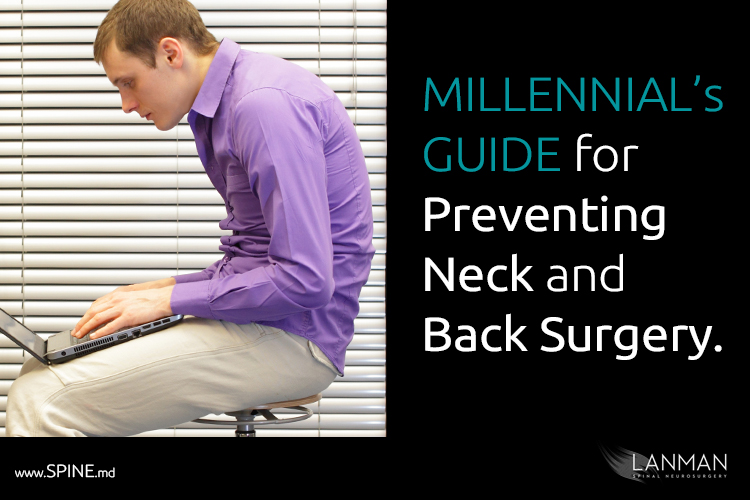Anyone born within five or six years either side of January 1, 2000, is a certified member of the generation we call the “millennials.” How this particular generation is dealing with the stresses of their emergence into adulthood is not so dissimilar to my generation of “boomers.”
We had post-Vietnam, hard rock, and the best live concerts ever performed by the greatest rock bands to ever walk the Earth (if I say so myself). Millennials have the post-Great Recession era, globalism, streaming video, and the widest range of entertainment and music taste any of us have ever seen. And they are also the first generation to not see corded phones as a regular fixture in their lives.
They, like us, also have their own unique set of challenges when it comes to health and potential spinal problems. But they also appear to be interested in meeting the challenge a lot earlier than my generation ever did. My 23-year-old daughter rolled this question out to me: “What can my friends and I do now to prevent neck or back surgery in our future?”
The simple answer, one that I tell all my patients no matter how old (or young) they are: do all you can to keep your musculoskeletal system as healthy as possible. This answer is usually followed by the three habits that come all the way down from my mom: maintain a good posture (standing, sitting), exercise regularly, and eat well.
With posture, it’s as easy as three words: Sit up straight! It’s actually the best thing you can do for your neck and lower back. It’s also a significant part of maintaining a healthy spine through your lifetime. Especially now, in our high tech world where the lifestyles of millennials is centralized around computers and cell phones. How many hours? Up to five hours a day in both leisure and work time on just phones. A recent survey found that the daily average nationwide crept up to more than 11 hours – per day!
As a neurosurgeon, I see the head tilting forward and all I can think of is all that structural stress pressing down on the spinal discs, wearing them down to inevitable herniation. We call it “text neck” and more and more younger patients are coming to me with similar complaints of chronic neck pain, tingling in their arms and fingers, and numbness. Almost certainly degenerative disc disease, or working toward that diagnosis. It’s an epidemic and it can be prevented. First, use a screen time app (the latest iPhone OSx update has one built in) and keep track of your screen time stats. Second, be aware that every hour you spend cranking your neck forward looking at Vines and memes brings you closer to corrective cervical (neck) surgery. Third, take a break and raise the phone up to eye level.
Sitting up straight at our computer screens is far easier. For those of us who still work at a desktop computer, keep your screen at or slightly below eye level to encourage a good sitting position. If you have to work on a laptop, use a stand to elevate your laptop screen along with a wireless keyboard and mouse. And again – make sure that your monitor is always eye-level; can’t stress that enough. Keep keyboards and pointing devices (mice) low, as close to waist level with supportive carpal tunnel pads to keep your neck and shoulders from “crunching up.”
Regular exercise is the second habit that everyone needs to think more about. It’s a great habit to pick up while you’re still young and an excellent way to keep bodyweight at manageable levels, especially as you push into your later adult years. Excess bodyweight can lead to damage to hip and knee joints. There are 24 joints in the spine. You do the math. Paired together with weakening muscle density (from lack of exercise), your entire musculoskeletal system is at risk for failure for every additional pound above your nominal body weight. Keep in mind also that excess body weight always complicates surgery and post-operative recovery.
Think of your muscles and spine as a cooperative system like cables holding up a bridge. Weakened muscles only invite injury. That’s why I’ll also suggest strength training exercises. You don’t have to go wild and get ripped, but core strength is vital for keeping your spine stable and centered.
For my patients, depending on their individual circumstances, I recommend high-intensity interval cardio training at least three times a week for 30 minutes. You can train on a stationary bike, elliptical stair step or swim laps in the pool. All are good cardiovascular exercises that also less likely to produce spinal injury. If you like to run, try to avoid paved areas as much as possible and use shoes that have good shock absorbing soles.
If you haven’t been to the gym in a while, go for low impact exercises. Try planking: holding your body rigid with elbows on an exercise mat. Start with three sets of 30 second intervals and work your way to 2 minutes or more. Yoga is good, but be very careful of over twisting your body. If you have more gym experience and access to equipment, try back exercises with a machine or a bench especially made for back extensions and sit-ups. Note that heavy lifting over the head, especially if you’re just getting started, is definitely not recommended.
Eating well usually means eating sensibly. Here’s a note straight from my nutritionists to Millennials: stop eating like a teenager. That means conscious eating, balanced meals, and a little bit of calorie counting. Plan your meals around your goals. If you’re trying to lose weight, gain muscle, or maintain what you have. Take inventory of macronutrients, distribute equal amount of fats, proteins, and carbohydrates. Focus on good fats from avocados and eggs. Eat plenty of protein such as steak, fish or chicken; plenty of fruits and vegetables; and avoid all refined sugars and excess starch. Most of all, drink plenty of water—at least 64 ounces per day (about eight cups).
Millennials. Learn from the Boomers. Adapt the old ideas and make them new: good posture, regular exercise, and eat well. After all, we all want to be Greater than Better.







